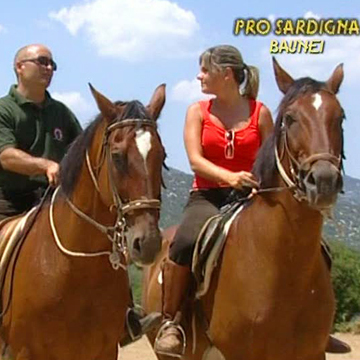The Coa 'e Serra nuraghe is located in the southern part of the Golgo Valley. The monument, difficult to read planimetrically due to the collapses and the dense shrub vegetation, appears to consist - in N - of a circular keep surrounded by a bastion, perhaps three-lobed, of which a circular tower with an ogival entrance of light is visible - in the quadrant facing W -.
The keep chamber is cluttered with rubble, but on the floor of the collapse it is possible to see a corridor below covered with a flat roof that connected - in S - with a roughly oval shaped compartment. The masonry of these structures consists of medium and large basalt blocks arranged in regular rows. To the S of this room there is a roughly trapezoidal building. The external wall of this building is different from that of the bastion: in fact, the boulders are arranged in irregular rows and their dimensions increase upwards. A rectangular entrance, arched and surmounted by an exhaust window, leads to the oval-shaped chamber. Around it there are traces of a village from the Nuragic age.
In 1974, an anthropomorphic betyl (1.21 m high) was placed in front of the church of San Pietro. The monolith, originally located a hundred meters farther away, has a human face carved in relief - in the middle part -. This representation suggests the comparison with the anthropomorphic protomes found on the truncoconic trunk of the bronze liturgical sign of Santa Maria di Tergu, dated to the 8th century BC. It is difficult to say if it is the representation of a god or an “intentional portrait” of the deceased: the artifact was originally associated with a megalithic tomb.
History of studies
The monument is marked by Antonio Taramelli.
Bibliography
A. Taramelli, “Sheet 208: Dorgali” in Archaeological Edition of the 100,000 Card of Italy, Florence, Military Geographic Institute, 1929;
G. Lilliu, “From aniconic betyll to nuragic statuary”, in Sardinian Studies, XXIV, 1975-77, pp. 73-144;
G. Lilliu, The Nuragic Civilization, Sassari, Carlo Delfino, 1982;
M.R. Manunza, “Archaeological Census in the Territory of Baunei (Nuoro): preliminary news”, in Journal of Prehistoric Sciences iche, 41, 1-2, 1988, pp. 351-357;
C. Nieddu, “Nuragic Complex of Co'e Sèrra”, in C. Nieddu (edited by) Archaeological Sites of Ogliastra, Tortolì 2006, pp. 24-25.
How to get there
From the center of Baunei, take the road that leads to the Golgo plateau, following the signs for the church of San Pietro. Once at the top, continue on the main road for about 5 km until you find a detour, on the d., indicated by a sign for the nuraghe. Continue on the dirt road for about km 2 to the nuragic complex. Continue on the main road for just over a kilometer and arrive on site, at the church of San Pietro.
Content type:
Archaeological complex
Archaeology
Usability: unmanaged site
Province: Nuoro
Common: Baunei
Macro Territorial Area: Central Sardinia
POSTAL CODE: 09040
Address: località Altopiano del Golgo
Update
Where is it
Images

Author : ambito punico/ ambito romano

Author : ambito romano
Results 2 of 112894
View AllVideo

Author : Floris Laura
Year : 2012
Results 2 of 41028
View AllAudio
Comments